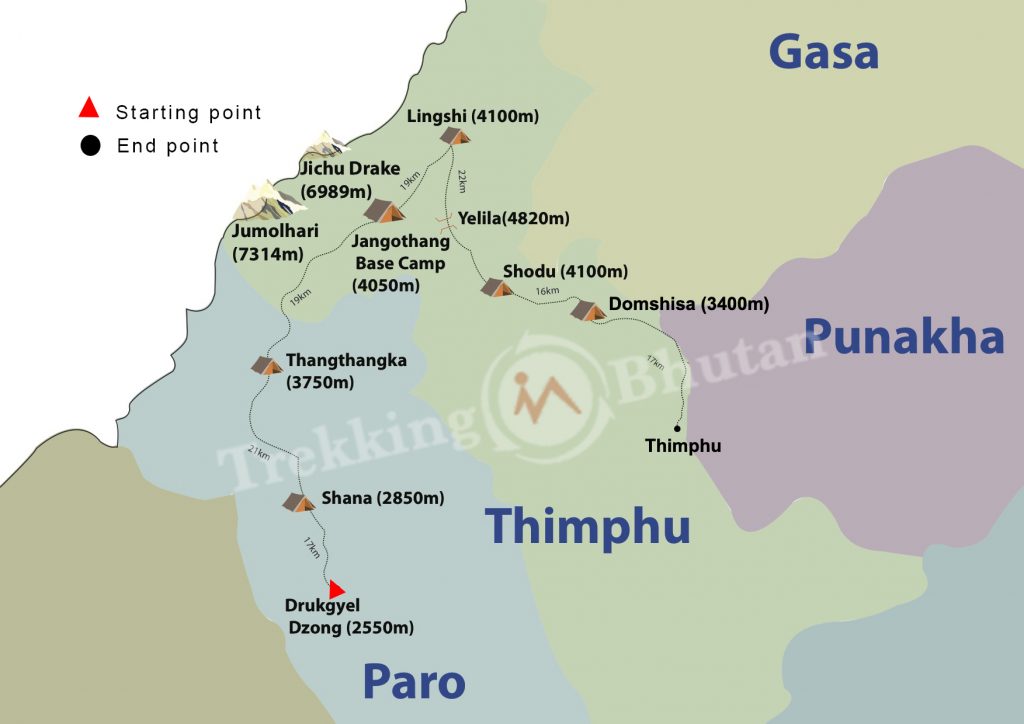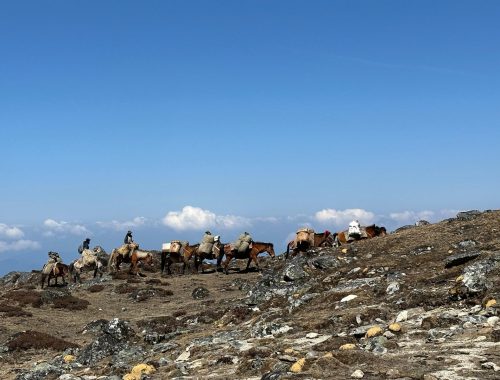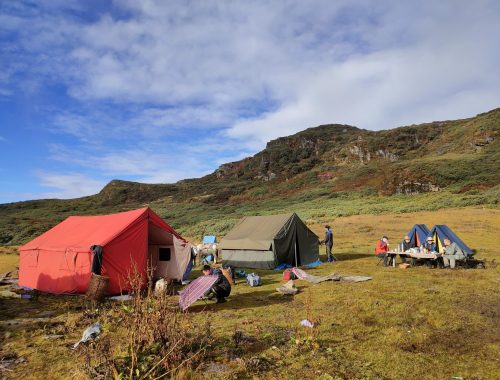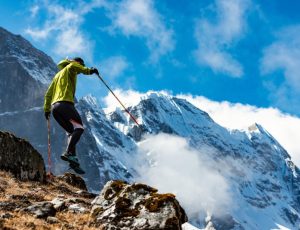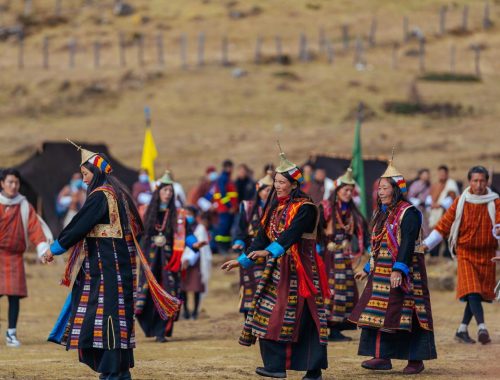Jumolhari Trek
or call +975 77845366
Jumolhari trek in Bhutan is an exhilarating adventure in the Himalayas.
Jumolhari Trek in Bhutan is one of the most enchanting adventure treks in Bhutan. After an acclimatization hike to Tiger’s Nest Monastery, you will start the trek from the historic Drugyel Dzong ruins north of Paro valley. The first three days of this trek follow the Pachhu or Paro river valley to Jangothang base camp from where you will have a stunning view of 7315m Mount Jumolhari, the second-highest unclimbed peak in the world. You will have a day of acclimatization here in preparation for the next few days. Day will be engaged in exploring nearby ridges and optionally to a twin lakes.
Next day, you will trek up through high pasturelands, loose stony trail to arrive at Neyle La Pass 4700m, which is marked by stone cairns and few prayer flags. Descend from the pass with a view of Lingzhi Dzong fortress. The next high pass after Lingzhi is the Yaklayla pass at 4942m. The pass offers astonishing views of Mount Jichu Drake (6989m) and Tsherim Gang (6789m). We then descend gradually along the downstream of Thimphu Chu river till you end your trek. Last two days will be spent in exploring cultural sights of Thimphu and Punakha valleys before your flight back home.
HIGHEST ALTITUDE
- 4942m
AVG. WALKING DISTANCE
- 17.5Km
AVG. WALKING TIME
- 6 Hours Average
MEALS ON TREK
- Breakfast, Lunch, Dinner & Snacks
Includes & Excludes
What's included
- Government levy/taxes & visa fee
- Transport by private vehicle
- Government approved 3-star hotels
- English speaking guide
- Bottled water in vehicle
- Permits, entrance fees, & sightseeing
- Sleeping tents, sleeping mats & pillows
- Dinning tents, kitchen tent & toilet tent
- Tables, chairs, utensils, hot water bags
- Trekking chef & assistants
- Horses to carry trek equipments
- Food supplies
What's not included
- Airfare
- Insurance
- Laundry
- Drinks & beverages
- Phone/internet bills
- Tips
- Wire transfer charge/card fee
- Sleeping bag
- Other bills of personal nature
Trek Route
The flight to Paro from Delhi or Kathmandu crosses the Himalayan mountains affording spectacular views. Flight from later offers more views of the Himalayas than former. Eighty two kilometers flight from Kathmandu, you will be greeted with the world’s tallest Mount Everest at 8849m, Lhotse 8515m, Makalu 8481m and Kanchenjunga 8586m of Sikkim among other mountains. Fifteen minutes prior to landing at Paro international airport, you will see sacred Mount Jumolhari 7326m and Jichu Drake 6662m north of the valley. On arrival you will be greeted by your guide and transferred to a local restaurant for a lunch. After lunch, if time permits, you have four sightseeing in Paro — Rinpung Dzong or fortress, which was built in 1646 now houses government offices and district monk body; a traditional wooden bridge; 8 th century old Kichu Monastery and the Drukgyal Dzong ruins, which was built in 1646 to commemorate Bhutan’s victory over Tibetan invaders during the 1600s. In the evening you can stroll through the Paro town. Overnight at a hotel in Paro.
After a breakfast, you embark on an acclimatization hike to Taktsang or the Tiger’s Nest Monastery, which is Bhutan’s most famous monastery. Start by driving to the base for 20 minutes and then hiking all the up to the monastery which is at 3100m. Hiking through forests of pine, fir and hemlock with the amazing views of Paro valley below, you will reach at flat portion of the trail where there is a line of small prayer wheels. Leaving the trail junction leading to the Cafeteria, we take right to continue further up till the look-out point from where you can see the whole monastery – it’s a good opportunity for a photography. Walk from the look-out point is down through the stony steps to the small water fall and then finally to the monastery. After paying visit, you will return to the cafeteria for a lunch. Then walk to the base where your car will be waiting for you to take you to hotel. Looking back to the monastery from inside your car gives you a sense of jubilation for having made a day by visiting it. On the way to hotel, you can stroll Paro town for some time. Overnight at hotel in Paro.
15KM | 5-6 HOURS | 300M ASCENT | DESCENT 60M | CAMP ALT 2870M
You will drive 12km north of Paro valley from your hotel to the trek start point at the historic Drugyel Dzong ruins (2580m). Your trekking crew will be waiting here for you. After a brief meeting, you will walk downhill on a wide trail following the Pachhu (river), which then climbs gently traversing through well-maintained rice terraces and fields of millet. Soon the valley widens and the route enters an area of apple orchards, traditional farmhouses and the tiny settlements of Mitshi Zampa and Sangatan. You reach the army post of Gunitsawa at 2,810 after walking for a while through blue pine forest. Here your trekking permit will be checked and stamped. This is the last stop before Tibet and border close to it. You will then cross Pachu River on a wooden bridge and then climb to Sharna Zampa at 2,870m. Just beyond Sharna Zampa, there are several meadows surrounded by trees where you will camp for tonight.
20KM | 8-9 HOURS | 900M ASCENT CAMP ALT 3750M
The trail again follows Pachhu (Paro river), ascending and descending through pine, oak and spruce forests. After 2 hours of continuous hiking and crossing several streams, you will reach at Shingkharap, a stone house at 3110m. This is a popular rest stops for the commuters and people from highland. A hot lunch will be served after crossing the bridge towards the left side of the river. Little ahead is the trail junction – left an old trade route and invasion from Tibet and right leading to the wooden bridge (we follow the right). After climbing up through rhododendron forests and finally crossing the bridge again, we reach our camp at 3750m, which is amidst beautiful meadows.
17KM | 4-5 HOURS | 290M ASCENT | CAMP ALT 4040M
Today you will go above the tree line at 3700m. From the camp, your path ascends for a while till you reach the army camp. Then follow the river above the tree line enjoying the stunning view of surrounding peaks. We walk through a very muddy section of trail, pass a mani wall and enter yak country. Hot lunch will be served inside a yak herder’s camp. After lunch, hike past yak herder settlements of Soe and Takethang. We walk our final leg of the trek across a plateau and up a stream bed and Dangochang village to the awesome campsite of Jangothang at an altitude of 4,040m. From here, the views of Mount Jumolhari and Jichu Drake are superb..
Today, you will tackle a four-hour acclimatization hike to the north of your camp. There is practically no trail but you will climb on an open and endless slope till you see the view of Mount Jichu Drakye (6989m). You can scramble further up till 4895m (higher than Mount Blanc) to see amazing view of Mount Jumolhari. You are likely to spot rare blue sheep, Himalayan rhubarb, griffon vultures, golden eagles and the remarkable blue poppy. Jangothang base is a flat grassy land with an old ruined fortress on a hillock in the foreground, beneath the colossal Mount Jumolhari and Jichu Drake. The other viable option is to go on two hours excursion to the twin Tshophu Lakes on the way to Bongtela Pass. Most people show signs of mountain sickness at this altitude and it is recommended that all trekkers halt here. If you do not wish to hike then simply relax in camp, either way it will be a memorable day.
18KM | 6-7 HOURS | 800M ASCENT | 730M DESCENT | CAMP ALT 4010M
The trail follows the stream for half an hour and crosses the bridge to the right side. Start the climb up to the first ridge with a breath-taking view of Jumolhari (7314m), Jichu Drake (6989m) and Tsherim Gang (6789m). Then walk towards the valley, almost flat for a while, until you climb to the Ngye La pass at an altitude of 4,830m. After the pass, it is a gradual descent to the camp, enjoying the panoramic view of the surrounding peaks and Lingshi Dzong. If time permits, you can have a detour to this tiny fortress, which is sitting on a hilltop overlooking Lingzhi village below. For centuries, Lingzhi Dzong was a way station for weary Buddhist pilgrims and defence fort against Tibetan and Mongol invaders. Camp at an altitude of 4010m.
19KM | 7-8 HOURS | 940M ASCENT | 920M DESCENT | CAMP ALT 4100M
The Laya-Gasa route leaves the Jumolhari trek here. The trek route climbs towards a small white Chorten on a ridge above the camp, then turns south up the deep Mo Chhu valley. The trail stays on the west side of the largely treeless valley, climbing steadily a short distance above Mo Chhu. It then crosses the river, and climbs steeply for two hours to Yeli La pass (4942m). From the pass, on a clear day, you can see Jumolhari, Gangchen Ta, Tsherim Gang and Masang Gang. Descend alongside a stream to a shelter, and then further downstream to a camp at Shodu (4100m), a meadow with a Chorten.
16KM | 5-6 HOURS | 250M ASCENT | 670M DESCENT | CAMP ALT 3600M
At this place, one comes back to the tree line. The path follows Thimphu River, descending through rhododendron, juniper and other alpine forests. The view of the cliff facing rocks and waterfalls is stunning. Hot lunch will be served by the riverside. After lunch the trail gradually ascends to the ruins of Barshong Dzong. This is a base from where it used to be supplying essentials to Lingzhi Dzong in olden days. You will camp in Barshong at an altitude of 3600m.
17KM | 4-5 HOURS | 200M ASCENT | 280M DESCENT
After a breakfast at the camp, you will start your hike first through the gradual ascent till you reach at the farm road. Walk through the farm road and make a detour descending gently through a dense forest of rhododendron, birch and conifers, and then drops steeply to meet Thimphu Chhu river. The trail stays on the left side of river, climbing over ridges and descending to side streams. Then the trail goes in and out steeply to the river and follows it southward to Dodena, elevation 2600m where you will be picked up by Bhutan Travelers transport and drive to Thimphu.
After breakfast, enjoy a scenic drive to Punakha with a stop at Dochu La pass 3,100m marked with 108 chortens where on a clear day you can get spectacular views of the Himalayan mountains. After a spending few minutes exploring the pass, you will drive downhill through the forests of rhododendron, fir, and hemlock. En route stop at Metsina and hike through rice paddies and up to the Chimi Lhakhang Temple. This temple is dedicated to the great Yogi of the 14th century known as Drukpa Kuenley, or the Devine Madman. Continue the drive to Punakha. You will arrive at Punakha after traversing through the rice field and along the bank of the Punakha River. After lunch, visit the Punakha Dzong, which is stunningly situated in between the male and female rivers like an anchored ship. The spot near the Punakha School and further ahead gives the best angle to capture wooden bridge, rivers and the dzong in one frame. Overnight at a hotel in Punakha.
Today you will drive back to Paro via the Dochula pass again and Thimphu. At Dochula, you can visit the new Druk Wangyel Monastery, which is the only of its kind in the country with elaborate paintings depicting the lineage of the present monarchy and their visionary works. After this continue to drive to Thimphu. If it is the weekend, head over the Centenary Farmers Market where farmers come together to sell their farm produce. Make sure to capture the colourful hues of vegetables, fruits and condiments. Continue to drive to Paro. In the evening, you can stroll in Paro town of your own and absorb the lifestyle of the people. Overnight at a hotel in Paro.
Drive to the airport for departure. Have a pleasant flight back home. Goodbye!
Dates & Itinerary Don’t Fit?
We can create a custom-made itinerary for you. Choose your date and place of travel and sights you would like to see.
- Email us at: @trekking-in-bhutan.com
- Call us at: +975 (M) 77845366
Similar Treks
Dagala Trek offers one of the most enchanting views of Thimphu valley and Lower districts in the south. The trek is a great opportunity to see high altitude lakes and yak pastures.
The trek runs along the mountains of Paro and Thimphu offering amazing view of the peaks. The trek trail meanders through rhododendron forests, green pastures and turquoise lakes.
The alpine quest, which is billed as the world's most difficult trek runs along the Northern border crossing highest pass of 5320 meters. Embark on this once in a lifetime expedition.
The trek is aptly been named as the Beautiful Laya Gasa Trek. The highlights of the trek includes: snow-capped majestic peaks, yaks & yak herder camps, flora & fauna and beautiful landscapes.

